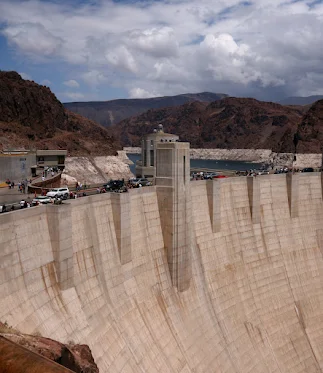Other storage technologies allow a more independent scaling of the maximum charge/discharge power from the maximum amount of energy the storage can hold, typically at a much lower marginal cost per additional unit of capacity.
One such example is pumped hydro storage, which is by far the most common form of large-scale electricity storage today. The input output power rating is determined by the configuration of the turbines, generators and pumps which contribute significantly to the cost of the installation. The storage capacity is determined by the volume of the water reservoirs, which can potentially be scaled at much lower cost but are subject to suitable terrain conditions. For example the recently completed Nant de Drance pumped hydropower plant has a maximum power of 900MW and a storage capacity of 20GWh for a storage duration of about 20 hours. The plant claims a round-trip efficiency of 80%, which is at the very high end for this type of storage which typically has an efficiency of around 70%.
Another storage technology with potential efficiency above 80% and the ability to scale storage capacity independently of input/output power are redox flow batteries. Other grid scale electricity storage technologies that have shown some potential in pilot installations are for example compressed air storage with efficiencies in the 60-70% range or molten salt thermal storage with efficiencies probably below 40% unless used for power & heat co-generation.
Using the day-ahead electricity market data for the Netherlands in 2023, which presented the highest single unit arbitrage potential in the previous post, we can now simulate multiple configurations with different round-trip yields and storage durations:
 |
| NL 2023 |
As expected, we see a drop in arbitrage potential per unit of storage capacity as the capacity increases. While the first unit of storage can match the charge & discharge points to the lowest and highest points in the market respectively, the second unit will need to match the second lowest and second highest points and so on. For optimal sizing on storage arbitrage alone, the per capacity marginal cost would have to decline faster than the arbitrage opportunity per capacity.
Also as expected, the arbitrage opportunity decreases as the storage efficiency decreases. However the relative decline of the revenue opportunity for the first few hours is less steep for lower efficiency systems. Depending on the relative cost of different storage technologies, it might make sense to combine expensive high-efficiency storage with short duration (1-10 hours) with less efficient but much cheaper long duration storage in the order of 6-24 hours.
For the market conditions in 2019 with presumably a much smaller difference between short term high and low prices, we can also see an increased sensitivity to efficiency: while at 90% efficiency, the optimisation algorithm could have found 733 profitable "trade" opportunities in 2019, at 40% efficiency there would have been only 145.
 |
| NL 2019 |
For some concrete examples, the above mentioned Nant de Drance pumped hydro storage plant with a power of 900MW, a storage duration of 20h and an efficiency of 80% could in the dutch day-ahead market have generated an arbitrage return of €27,025,200 in 2019 and €274,866,300 in 2022. The very roughly estimated cost for this plant based on the investment of 2 billion CHF a long term utility bond rate of 1.25% over 30 years and an annual operating cost of 2% comes to about 120M CHF per year.
By comparison, a quick search on the internet shows 20kWh Lithium-ion (LFP) based home storage systems for around €14k (i.e. €700k per MWh) Assuming a 10 year amortisation at current mortgage rates of 3% would yield an annual cost of about €82k for a storage system of 1MW/1MWh vs the €89k arbitrage opportunity in 2022. Current Lithium-ion battery pack prices should be around $100 per kWh (Bloomberg) and the balance of system costs for a single grid-scale battery-electric storage system should be much lower than stacking up 50 home storage systems at retail prices. Assuming a 3x overhead or a rough cost of €300k per MWh amortised over 10 years at 3% would result in an annual cost of €35k vs. an arbitrage opportunity of €89k in 2022 or €10k in 2019.
While electricity storage costs are far from being cheap, they could under some circumstances be in the range of competing with gas peaker plants which typically set the market price during high demand periods without solar & wind oversupply. If or when this would be the case largely depends on the continued buildout of wind and solar increasing the hours of oversupply, the market rate for natural gas, the cost of CO2 emissions certificates, the allocation of government subsidies and the continued cost decline for various storage technologies.
Besides short-term energy arbitrage there are also other, presumably more lucrative reasons to deploy more storage in power grids today. These range from providing grid stability and control to providing spare capacity to ensure a long-term security of the energy supply.
